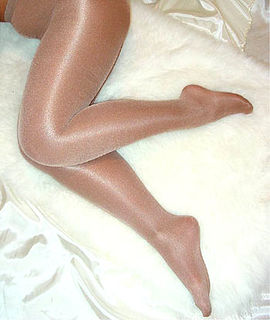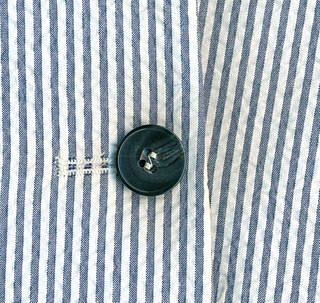
Marquisette is a lightweight, sheer fabric that has a structure similar to a mosquito net.

Marquisette is a lightweight, sheer fabric that has a structure similar to a mosquito net.
Marquisette is a very loose weave construction plain and sometimes with designs. Leno is one type of weaving the marquisette. Marquisette may be made with many natural or synthetic yarns, and the most common is nylon. The other variants are possible with cotton, silk, rayon, orlon and polyester. [1]
Marquisette is employed in certain undergarments, [2] and is seen in dresses such as bridal wear and evening wear. It can commonly be seen in sheer draperies and curtains. [1] [3]

Pantyhose, called sheer tights, or tights, are close-fitting legwear covering the wearer's body from the waist to the toes. Mostly considered to be a garment for women and girls, pantyhose first appeared on store shelves in 1959 for the advertisement of new design panties as a convenient alternative to stockings and/or control panties which, in turn, replaced girdles.

Pinking shears are scissors with sawtoothed instead of straight blades. They produce a zigzag pattern instead of a straight edge.

A ribbon or riband is a thin band of material, typically cloth but also plastic or sometimes metal, used primarily as decorative binding and tying. Cloth ribbons are made of natural materials such as silk, cotton, and jute and of synthetic materials, such as polyester, nylon, and polypropylene. Ribbon is used for useful, ornamental, and symbolic purposes. Cultures around the world use ribbon in their hair, around the body, and as ornament on non-human animals, buildings, and packaging. Some popular fabrics used to make ribbons are satin, organza, sheer, silk, velvet, and grosgrain.

A stapler is a mechanical device that joins pages of paper or similar material by driving a thin metal staple through the sheets and folding the ends. Staplers are widely used in government, business, offices, work places, homes and schools.
Lawn cloth or lawn is a fine plain weave textile, made with fine combed cotton. Terms also used include batiste and nainsook. Originally the name applied to plain weave linen, and linen lawn is also called "handkerchief linen". The term lawn is also used in the textile industry to refer to a type of starched crisp finish given to a cloth product. The finish can be applied to a variety of fine fabrics, prints or plain.

A toupée is a hairpiece or partial wig of natural or synthetic hair worn to cover partial baldness or for theatrical purposes. While toupées and hairpieces are typically associated with male wearers, some women also use hairpieces to lengthen existing hair, or cover a partially exposed scalp.

A curtain is a piece of cloth or other material intended to block or obscure light, air drafts, or, water. A curtain is also the movable screen or drape in a theater that separates the stage from the auditorium or that serves as a backdrop/background.

A camisole is a sleeveless undergarment or innerwear typically worn by women, normally extending to the waist. The camisole is usually made of satin, nylon, silk, or cotton.
Voile is a softly, sheer fabric, usually made of 99% cotton or cotton blended with linen or polyester. The term is French for veil. Because of its light weight, the fabric is mostly used in soft furnishing. In tropical climates, voile is used for window treatments and mosquito nets. When used as curtain material, voile is similar to net curtains.

Seersucker or railroad stripe is a thin, puckered, all-cotton fabric, commonly striped or chequered, used to make clothing for spring and summer wear. The word originates from the Persian words شیر shîr and شکر shakar, literally meaning "milk and sugar", from the resemblance of its smooth and rough stripes to the smooth texture of milk and the bumpy texture of sugar, respectively. Seersucker is woven in such a way that some threads bunch together, giving the fabric a wrinkled appearance in places. This effect is often achieved during weaving by warp threads for the puckered bands being fed at a greater rate than the warp threads of the smooth stripes. This feature causes the fabric to be mostly held away from the skin when worn, facilitating heat dissipation and air circulation. It also means that pressing is not necessary.

Cambric or batiste, is a fine dense cloth. It is a lightweight plain-weave cloth, originally from the French commune of Cambrai, woven greige, then bleached, piece-dyed, and often glazed or calendered. Initially, it was made of linen; later, the term came to be applied to cotton fabrics as well. Chambray is the same type of fabric, with a coloured warp and white filling; the name "chambray" replaced "cambric" in the United States in the early 19th century.

Ninon is a lightweight, sheer fabric made with plain or leno weaving, it is a suitable material for curtains, evening wear and lingerie. Ninon is made with variety of filament yarns such as polyester, silk, rayon or nylon.

Toe socks are socks that have been knitted so that each toe is individually encased the same way as fingers within a glove.

Chiffon (French: [ʃi.fɔ̃];, shif-ON is a lightweight, balanced plain-woven sheer fabric, or gauze, like gossamer, woven of alternate S- and Z-twist crepe yarns. The twist in the crepe yarns puckers the fabric slightly in both directions after weaving, giving it some stretch and a slightly rough feel.

Organdy or Organdie is a kind of sheer fabric. It is a lightweight balanced plain weave cotton with features of sheerness and crispness.

Soutache, also known as Russia braid, is a narrow flat decorative braid, a type of galloon, used in the trimming of drapery or clothing. Soutache is created by weaving a decorative thread around and between two parallel cords and completely covering the cores; this produces a piece of trim with a braided or herringbone pattern. Often woven of metallic bullion thread, silk, or a blend of silk and wool, soutache began to be made of rayon and other synthetic fibers in the 20th century.

A charvet fabric is woven of silk or acetate in warp-faced rib weave, of a reversed reps type with a double ridge effect. The fabric's name derives from its frequent and "clever" use in the 19th century by the Parisian shirtmaker Charvet. It is characterized by a soft handle and shiny appearance. It also drapes well. The bindings create a herringbone effect parallel to the warp, which make this weave suitable for creating faint diagonal stripe effects for ties, for which the fabric is cut on the bias. Patterns on this base are often made with supplementary weft. The fabric has also been used for mufflers, scarves and robes.
Casement cloth is a lightweight sheer fabric made of various fibers used chiefly for curtains.

Brocatelle is a silk-rich fabric with heavy brocade designs. The material is characterized by satin effects standing out in relief in the warp against a flat ground. It is produced with jacquard weave by using silk, rayon, cotton, or many synthetic yarns.
Gossamer fabric is a thin, sheer woven fabric. The structure of the fabric is similar to a gauze. It is usually made of silk, cotton, or wool. The fabric may be coated with rubber to make it waterproof.